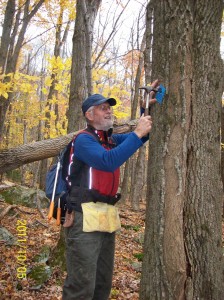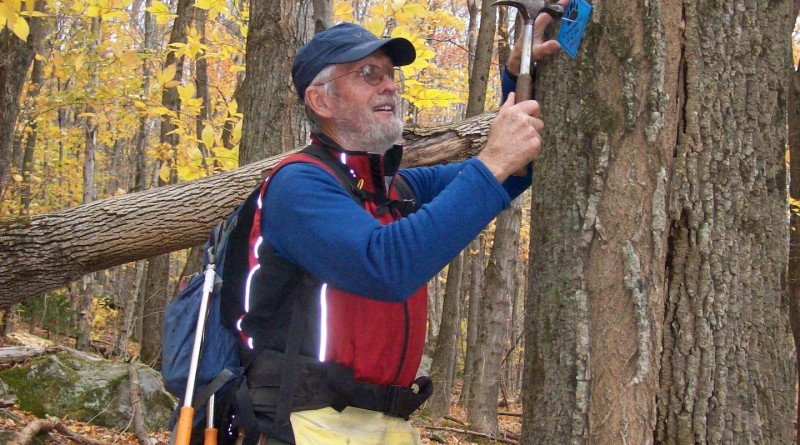Craig Hadden | Reader Athlete Dec. 2011
Age: 72
Residence: Barnard
Family: Wife, Joan; two children, and six grandchildren
Occupation: Semi-retired engineer
Primary sport: Backcountry/Catamount Trail skiing, canoeing
VS: What does “semi-retired” mean?
CH: I worked for almost four decades for a company based in Bethel that builds manufacturing plants. I retired seven years ago, but they keep calling me back to work for them. Right now I’m spending time in Costa Rica, overseeing the building of a plant there.
VS: You mentioned the Catamount Trail specifically. Why did you emphasize that?
CH: I love the beautiful quietness of it. Sometimes when I’m skiing I’ll just stop. You’re by a beaver pond and all you see is the woods around you, and blue skies above, and not a single sound. It’s a beautiful, quiet place. I also think it’s unique. I’ve skied all over including winter backpacking trips in Colorado, the Adirondacks, Canada, and even Norway. Few places are as good or as satisfying as the Catamount Trail.
VS: Tell us about some of those trips.
CH: There is a core group of us who go on multi-day outings, often 100 kilometers, taking everything we need with us. I prefer going hut to hut because you get four sides to protect you from the wind. Plus, there’s nothing like sitting in the wilderness with a stove and getting the inside temperature up to 40 to 50 degrees for dinner. We divide the chores so two people take turns doing the cooking each night. One of my favorite areas is Charlevoix, Quebec. You go from log cabin to log cabin, and they even provide pots and pans so you don’t have to carry as much.
VS: And when winter is done, your big sport is canoe racing, correct?
CH: I do about a dozen races, mostly in the Adirondacks. The New York Marathon Canoe Racing Association has an extensive series with more than a dozen races. Some people make the 200-mile club for the number of miles they’ve raced, and others are in the 400-mile group. This year, because of Costa Rica, I was only in the 200-mile group.
VS: Do you race the Adirondack Canoe Classic?
CH: I do. It’s a 90-mile race over the course of three days. The first day is six-and-a-half to seven hours long, and unless you go nonstop, you can’t do it. You can’t stop to look at the scenery or go into coves to look for wildlife. This year we didn’t do that well the first day, but we did better the second and third.
VS: So you don’t race alone?
CH: I race tandem canoes and I’ve had the same partner for the last 12 years. During that time we’ve each raced 60 to 70 times and were together for all but maybe three of them. We actually met on a bus during a multi-day race. He lives in Albany, N.Y,. and we used to try to train together before races, but the cost of gas is so high and we know each other so well that we just meet on the day of the race and we’re still in sync. I’m the navigator and he steers from the back. We have a great relationship and we talk most of the time we’re in the boat. Years ago we used to win in our age class, but some of the better paddlers are getting older now and they’re moving into our division.
VS: What is the advantage to a canoe over a kayak?
CH: It has to do with the portaging. On the Adirondack Canoe Classic there are eight portages totaling about 5 miles. My partner had his knee replaced but I can still carry our boat myself. Its 18 1/2-feet long, but it’s only 40 pounds. However, if I’m going out for a day paddle with no portage, I might take a kayak. I build strip canoes and kayaks and have about a dozen boats including recreational and racing tandem and solo canoes, and four or five kayaks.
VS: Where do you paddle locally?
CH: I train at Silver Lake in Barnard which is a beautiful area. Early in the year, before July 4th, I also practice at Lake Bomoseen.
VS: Getting back to skiing, you’re a Trail Chief for the Catamount Trail. Tell us about your section.
CH: I cover sections 14 and 15 between Mountain Top and Blueberry Hill. Part of it is on snowmobile trails, but we’ve been able to find some secondary trails off the main route and often we don’t see a single snowmobile. The second part used to go along a power line and for the last six to seven years we’ve been looking to relocate that. Every year we’d flag the proposed section and reflag it the following year. I thought it would never happen, but this year we finally did it and recently we officially marked the trail with blazes.
VH: What motivates you to help out?
CH: When I moved to Vermont almost 40 years ago someone told me they hiked in the White Mountains. I knew nothing about hiking or the Whites, and they showed me. Eventually I hiked all 48 4,000-footers and even guided there. It was all because someone said “come with me.” How else do you learn? I lead ski trips on my section and we get between eight and 12 people. I interview everyone before we start out and I help them get the right equipment and I also watch them during the trip to make sure they don’t have frostbite or hypothermia and they hydrate properly. Generally I get some who have skied before who can help by being my sweeps since I try to be up toward the front. Some people swoop down the steep stuff and some are hugging the trees, but when we’re all done, we’ve skied it together. I’ll be honest; this isn’t about “giving.” I enjoy it. I really enjoy showing people the joys of skiing the Catamount Trail.

